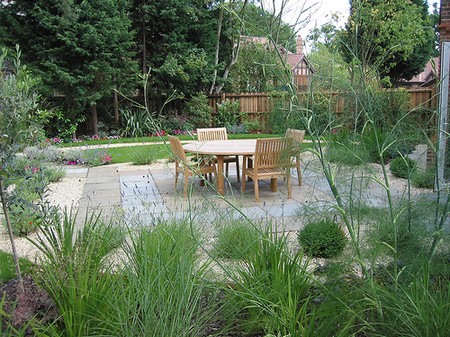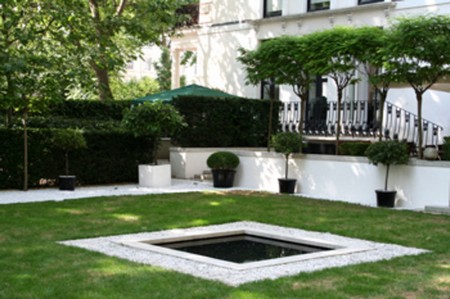Best Way to Build a Semi-Formal Square Garden
The semi-formal nature of this garden comes from the fact that it is designed around a geometrical shape and all the paving and raised beds are symmetrical. The garden is balanced by the chairs, set diagonally to emphasize the axis, and by the planters either side of the seat. The other corners are softened by containers and planting so it is formal, yet not formal.
Every available surface is used for growing plants, and there is even trellis along the tops of the walls so that plants can soften every area. Using raised beds of different depths and sizes introduces dramatic changes of level and allows for a huge variety of planting within the small area. The deep beds at the rear of the garden and along the sides allow larger shrubs and plants to create a sense of privacy.
There is no one dominant feature in this garden. Rather, the eye is led to all areas, and visitors to the garden are drawn to each area for subtly different reasons.
Features
The uniform, cream-coloured paving stones create a central area that is light and airy, and their square shape subtly reinforces the shape of the site. They reflect light and create an open, welcoming feel.
The frosted glass window on the right-hand side of the garden provides shelter without shade on the patio and screens an unattractive view. It emphasizes the boundary while allowing in lots of light. Two windowboxes attached to the wall bring flowers up to the level of the bottom of the window. Because the garden is small a permanent structure is not practical, but shade is adequately provided by a small tree. Even the top of the wall has containers along it to raise the level of screening and add variety. These are filled with exciting and colourful plants to encourage the eye upwards.
The furniture, which is all white-painted wood to create a sense of unity, is positioned so that the welcoming table and bench are opposite the doorway, enticing visitors into the garden and creating the feel of another room added to the house.
Planting
Plants cover every wall to link the garden to the house and beckon you into the space to explore. The group of larger containers by the door hides an area of the garden from view, creating intrigue and encouraging a desire to investigate further.
The two trees, Betula pendula (silver birch) and Acer griseum (paper-bark maple), although of different genera, have the same habit and periods of interest and balance each other. At all sides, plants spill out from the raised beds and planting areas into the garden, and containers are randomly placed to offset the formality and create a pretty, semi-formal garden with an ordered but relaxed feel to it.
The shape and form of the plants is varied, and there are lots of colours to create an ever-changing canvas and bring each area of the garden into its own over the year. Some unusual and stunning plants, including Phoenix roebelenii (pygmy date palm), lend themselves to this semi-formal setting. Plants with spiky shapes, like Phormium ‘Dazzler’ and Agave americana ‘Marginata’, contrast with the tumbling, softer nature of their neighbours. The grass Festuca glauca ‘Elijah Blue’ in a pot adds a touch of elegance to the shady area.
The flower colours are largely pale shades to help to create a spacious feel, but there are also splashes of bright colour to create contrast, and one or two focal plants are in containers to provide talking points and appealing contrasts. Several scented climbers will allow their scent to drift on the air in the enclosed space on summer days.
A grapevine, Vitis davidii, grown on trellis attached to the house wall will smother the brickwork with foliage and produce small bunches of delicious grapes later in the year. Planting against the glass screen is kept light, to allow maximum light through and create dappled shade in the garden.
Containers hold a range of plants, from masses of bright annuals to single formal plants. These can be grouped of dotted around to create different moods or just for a change. The mix of formal plants, such as the majestic vertical spires of Eremurus stenophyllus and Verbascum chaixii ‘Gainsborough’, planted near trailing evergreens, flowers and shrubs creates a disordered yet harmonious feel to the beds and contrasts beautifully with the formality of the paving slabs.
Categories
Advertisements
Recent Articles
 How to Understand Bed Sizes – A Small Guide
How to Understand Bed Sizes – A Small Guide How to Select Some Must Have Kitchen Accessories
How to Select Some Must Have Kitchen Accessories Best Way to Change a Car Tire
Best Way to Change a Car Tire Best Way to Write an Affirmation
Best Way to Write an Affirmation Best Way to Take Charge of Your Financial Life
Best Way to Take Charge of Your Financial Life Best Way to Survive a Party When You Don’t Know Anyone
Best Way to Survive a Party When You Don’t Know Anyone Best Way to Stop Self Sabotaging Yourself
Best Way to Stop Self Sabotaging Yourself Best Way to Start Journal Writing
Best Way to Start Journal Writing Best Way to Speak with a Powerful Voice
Best Way to Speak with a Powerful Voice Best Way to Simplify Your Life
Best Way to Simplify Your Life Best Way to Respond to a Put-Down
Best Way to Respond to a Put-Down Best Way to Reduce Acne Breakouts
Best Way to Reduce Acne Breakouts Best Way to Recover from Dining Disasters
Best Way to Recover from Dining Disasters Best Way to Quit Your Job Gracefully
Best Way to Quit Your Job Gracefully Best Way to Make Your Own Website
Best Way to Make Your Own Website



Leave a Reply